Introduction
Artificial intelligence (AI) moves from the Star War type of fictional reality to full acceptance as a valuable success enabling tool among leading private and public sector enterprises globally. At its core, AI refers to an environment and settings where a device mimics human minds’ cognitive functions. These cerebral activities include comprehending, expressing, perceiving, calculating, remembering, organizing, reasoning, imagining, creating, and problem-solving. AI is a smart decision engine that can exponentially increase healthcare professionals’ effectiveness and efficiencies to improve patient care and quality of life.
“A full 84% of C-suite executives believe they must leverage artificial intelligence (AI) to achieve their growth objectives. Nearly all C-suite executives view AI as an enabler of their strategic priorities. And an overwhelming majority believe achieving a positive return on AI investments requires scaling across the organization.”
Accenture
Artificial intelligence in healthcare uses software to approximate human cognition in the analysis of complex medical data. In healthcare, the impact of AI, through natural language processing (NLP), machine learning (ML), and robotics are changing the healthcare paradigm. Precisely, AI provides the capability for computer reducing algorithms to approximate conclusions, without direct human input, to support increased healthcare productivity, significantly lower healthcare insurance costs and out-of-pocket expenses, and improve overall patient care outcomes quality. It does this by primarily gathering and crunching massive amounts of data quickly and intelligently to identify patterns often overlooked or undiscovered in the traditional practice of care.
Today, leading healthcare leaders to recognize the potential of AI as a valuable strategy to diagnose disease and sickness, create more effective treatments, and develop innovative medicines more quickly. AI-based technologies have proved, over the last decade, that they can effectively emulate and supplement the power of the human brain and provide real and advanced life-saving and quality-of-life treatment solutions.
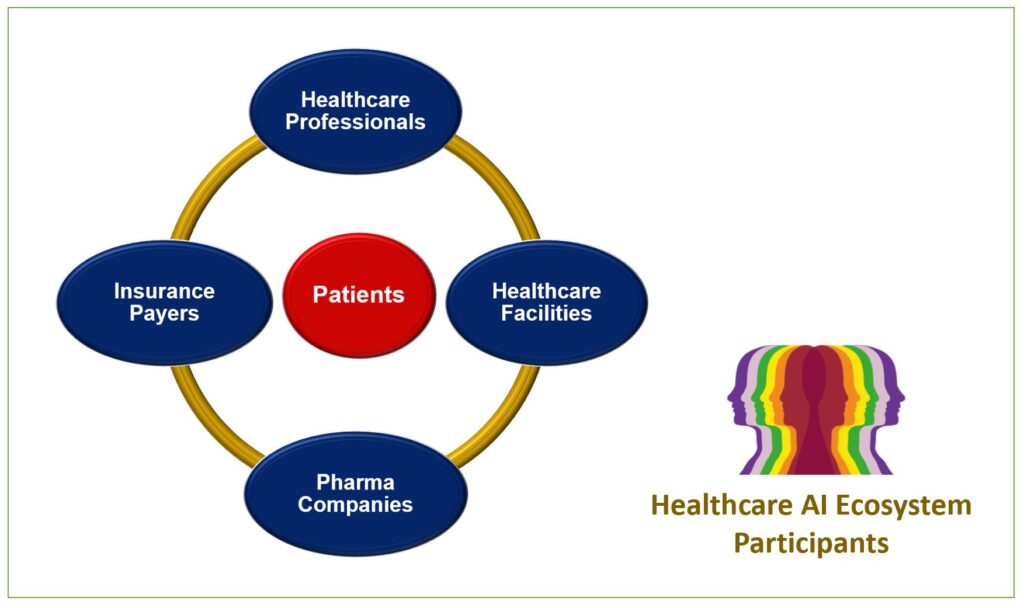
Artificial intelligence is not one technology but rather an assemblage of many approaches and tools. Most of these systems have immediate relevance to healthcare improvement, but the specific processes and tasks they support may vary. While each AI solution provides significant value individually, the enormous potential lies in the synergies created by using them holistically together across the entire patient journey, from diagnoses to treatment, to ongoing wellness. An integrated approach represents a more practical use of AI, resulting in eliminating unnecessary time and decision delays and mistakes in the patient treatment cycle.
The use of AI to support healthcare practices has many proponents and skeptics among the professional community. The table below highlights some key pluses and minuses of AI healthcare solutions.
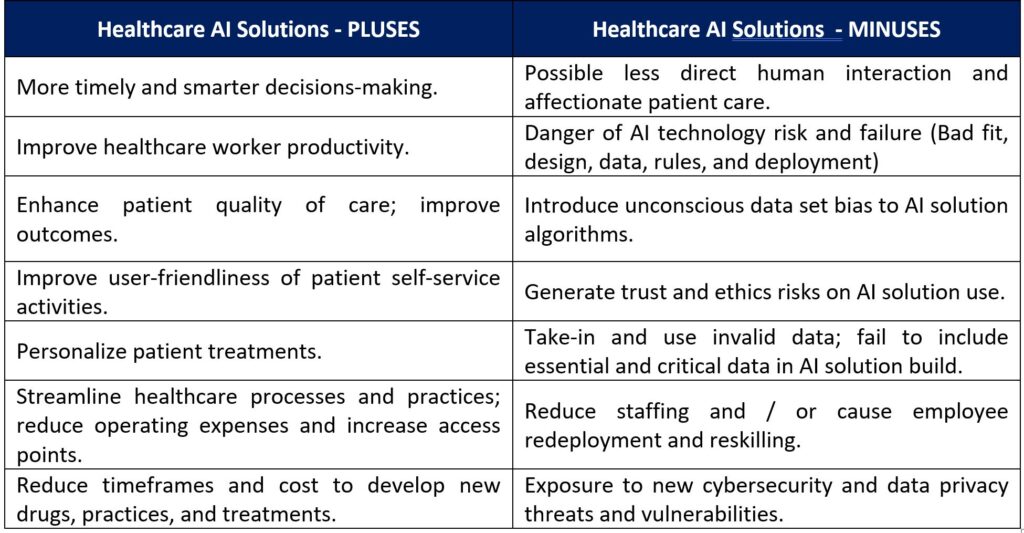
The challenges in operationalizing and integrating artificial intelligence solutions into existing healthcare systems are numerous, even though this technology set is one of the most substantial growth areas in the biomedical field. The AI community must develop and employ a formal structure incorporating best practices for ethical inclusivity, software design and development, implementation and support science, and human-computer interaction.
“Although some AI applications for health care business operations are likely to be poised for full automation, most of the near-term dialogue around AI in health care should focus on promoting, developing, and evaluating tools that support human cognition rather than replacing it.”
National Academy of Medicine
Artificial Intelligence Definition
The term “Artificial Intelligence” (AI) can be challenging to define as there are a profusion of AI terms and descriptions commonly used by academia, researchers, vendors, and businesses. A topical story of AI follows below.
Artificial intelligence (AI) is intelligence exhibited by systems and devices that respond to stimulation consistent with normal human responses with the application of rapid data processing, machine learning, predictive analysis, and automation to simulate intelligent behavior and problem-solving capabilities. AI mimics human cognitive functions with qualities, including intentionality, intelligence, and adaptability.
Shown in the below table are the commonly recognized applications and approaches associated with AI.

Increasingly, AI is penetrating most aspects of our family, social, and business environments. It is now used in the background of many routine tasks, powering virtual assistants such as Alexa and Siri, providing entertainment and other suggestions from and Netflix and Amazon, and supporting billions of web searches daily. The AI value for healthcare has produced significant examples to date, but most healthcare leaders acknowledge that the best is yet to come!
“AI-based systems must be continuously trained, monitored, and evaluated for performance if organizations are to realize their full benefits while guarding against bias, privacy violations, and safety concerns.”
Microsoft
AI and Preventable Healthcare Professional Mistakes
At a minimum, healthcare should not harm patients, mainly through medical errors. However, healthcare professionals’ mistakes are a continual challenge for successful patient care and a crucial well-recognized performance indicator (KPI) of medical and healthcare facilities. Market research reports that hospitals experience a level of fatalities resulting from preventable errors, comparable with heart disease and cancer.
Over the years, many research studies have struggled to quantify the direct and indirect costs of measurable medical human errors. From National Center for Biotechnology Information, the most recent research reported measurable human error cost in the US at about US$17.1 billion, with 2,500 additional deaths and over 10 million excess days missed from work due to short-term disability.
Many fatal errors are associated with healthcare technology design flaws, as found in system algorithms and calculations and interpretation and use of the healthcare systems by healthcare professionals supporting patient care and research activities.
AI can reduce the current level of human error and improve healthcare services. Many healthcare errors are avoidable by applying current artificial intelligence techniques on existing medical data to predict high-risk error situations. Since most of the conditions leading to human-induced errors are known and well-studied, predicting and preventing them is more attainable in the design and deployment of AI-based solutions.
Institute of Medicine defines a medical error as the failure of a planned action to be completed as intended or using a wrong plan to achieve an aim.
The Quality Interagency Coordination Task Force, a Federal Agency for Healthcare Research and Quality, describes medical error as a failure of a planned action to be completed as intended or the use of a wrong plan to achieve an aim. Errors can include problems in practice, products, procedures, and systems.
National Center for Biotechnology Information
Healthcare AI Value-Add Solutions
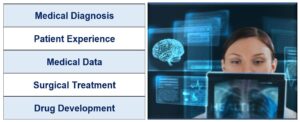 The accompanying graphic highlights an array of healthcare categories with AI solutions currently in productive use or involved in various stages of research and development projects.
The accompanying graphic highlights an array of healthcare categories with AI solutions currently in productive use or involved in various stages of research and development projects.
AI has many potentially beneficial uses in the healthcare community. The solutions described below are not the only AI developments in healthcare. Many leading academic institutions and the private and public sectors continually invest and develop new AI solutions under the radar.
Medical Diagnosis
The Situation
Medical diagnostics, a time-consuming and challenging process, places physicians under time pressures and strain and may result in delayed or incorrect life-saving patient reports. Coupled with the problems of incomplete patient health histories and large caseloads, the potential for deadly human error risk is a critical concern. Machine Learning (Deep Learning) algorithms can automatically detect diseases, making diagnostics less expensive and more accessible by learning to distinguish patterns similar to how health professionals see them.
Implanting AI into diagnostics practices lessens human error potential and reduces clinical lab time and unnecessary tests. For healthcare professionals, AI-enabled diagnostics result in more correct patient treatment plans and increase physician-patient face time and care. For patients, more dependable diagnoses improve positive treatment outcomes and limit preventable deaths.
Examples: AI-enabled Solutions
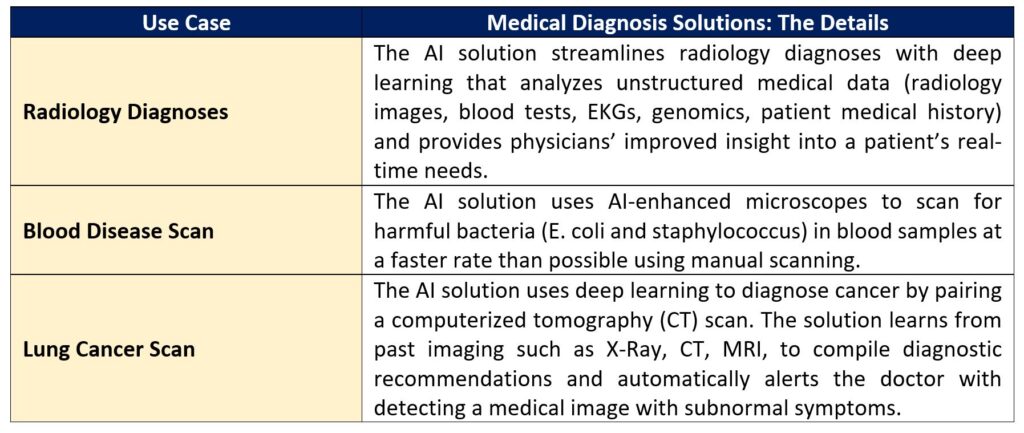
Patient Experience
The Situation
People are proactively getting involved in organizing and managing their health via smart self-management portals that provide greater control over their lives. Within this environment, a positive feedback loop can share peoples’ needs and preferences collected using an AI solution with other AI applications throughout the healthcare delivery system, providing quick and more reliable wellness, treatment, or diagnostic assistance.
AI-supported wearables and mobile-connected devices also help individuals improve health-related choices supporting conditions such as asthma, COPD, heart arrhythmia, and pain management. AI solutions, integrated within these consumer-type technologies, provide valuable patient feedback on healthcare data elements captured on their devices, for example, medication adherence or a motivational voice that encourages fitness activities and healthy wellness habits. Also, these self-management solutions help family and caregivers support patients unable to care for themselves.
Examples: AI-enabled Solutions
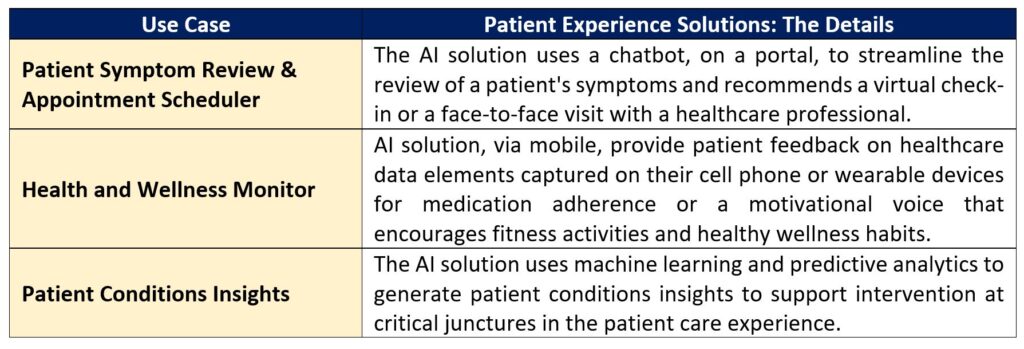
“Apart from brief consultations, doctors now have few tools to help patients with chronic conditions adopt healthy lifestyles. In the future, digital therapeutics, powered by AI, patient data, and behavioral science, can use gamification and other forms of engagement to help patients adopt and sustain healthy behaviors.”
McKinsey & Company
Medical Data
The Situation
Data are critical for providing evidence-based healthcare and has been problematic in collection and analyses over the years. It is now typical for vast amounts of data to be generated about an individual from various sources, such as claims data, genetic information, radiology images, intensive care unit surveillance, electronic health record care documentation, and medical device sensing and surveillance. Data generation is continually increasing, resulting from the scaling of computational capacity through decreases in technology cost, widespread adoption of electronic health records (EHRs) promoted by the Health Information Technology for Economic and Clinical Health (HITECH) Act, the use of artificial intelligence.
AI solutions provide a faster, more consistent approach for collection, storage, reformatting, and analyses of structured and unstructured data supporting patient and healthcare research and related decisions. The underlying AI technologies can examine patient data’s meaning and the context in clinical notes and reports combined with clinical expertise and external analysis to identify and pinpoint potential patient treatment pathways and plans. AI is rapidly transforming medical data into insights and predictions that improve operational effectiveness and reduce operational expenses.
Examples: AI-enabled Solutions
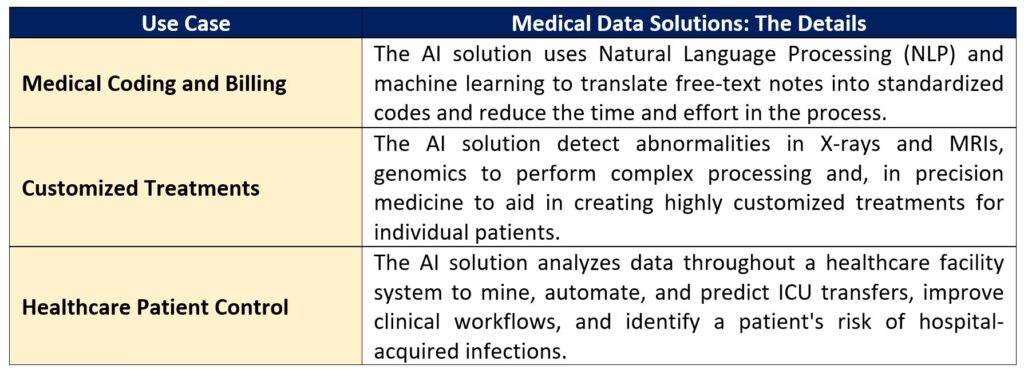
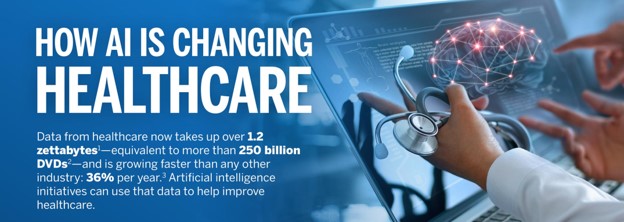
Intel / Wall Street Journal
Surgical Treatment
The Situation
AI solutions help surgeons perform exceptional precision surgeries in tight spaces and with fewer involuntary hand movements that would be possible by the human hand alone. Surgical robot solutions can control the trajectory, depth, and speed of their actions with high accuracy and uniquely suited for procedures that require repetitive movements. Robots can continually determine surgical procedure patterns to improve best practices and improve surgical robots’ control accuracy to submillimeter precision. The use of AI-based surgical systems results in fewer complications than surgeons without the availability of AI resources.
A loss of motor skills sometimes impedes the skills, experiences, knowledge, and insights that surgeons accumulate over their medical professions. AI robotic solutions help lessen the consequences of hand tremors and avoid unintended or accidental movements during surgery.
Research supports that more than 5,000 surgical robots were used in more than one million procedures worldwide in the last year. The robotic surgeries included: general surgery, orthopedics, neurology urology, gynecology, thoracic, bariatric, rectal, colon, and oncology.
Examples: AI-enabled Solutions
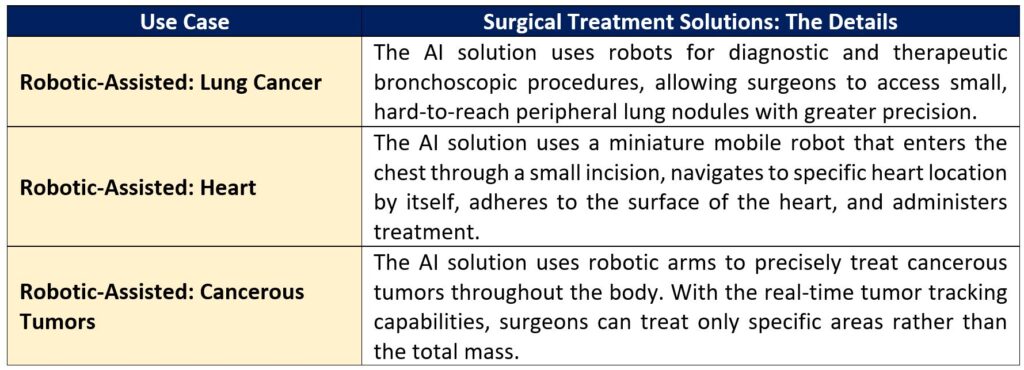
Drug Development
The Situation
In the pharmaceutical world, new drug development and approval, with FDA oversight of individual rigorous clinical practices and trials begin with animal trials and progressively moving to humans. Drug research and development activities predictably are expensive over the long term, requiring significant financial investment and the right professional and scientific talent to support the potential completion of a positive outcome.
AI technologies help companies aggregate and synthesize the massive amount of information needed for clinical trials, thus reducing the drug development process. It also helps:
- Recognize and comprehend the mechanisms of the disease;
- Establish biomarkers;
- Generate data, models, or novel drug candidates, design or redesign drugs;
- Run preclinical experiments.
- Plan and run clinical trials and even analyze the real-world experience.
A vital component of the process is the US Food and Drugs Administration (FDA) interactions to obtain regulatory approval. It is not uncommon for developments to take countless years to complete, at times, more than a decade.
Examples: AI-enabled Solutions

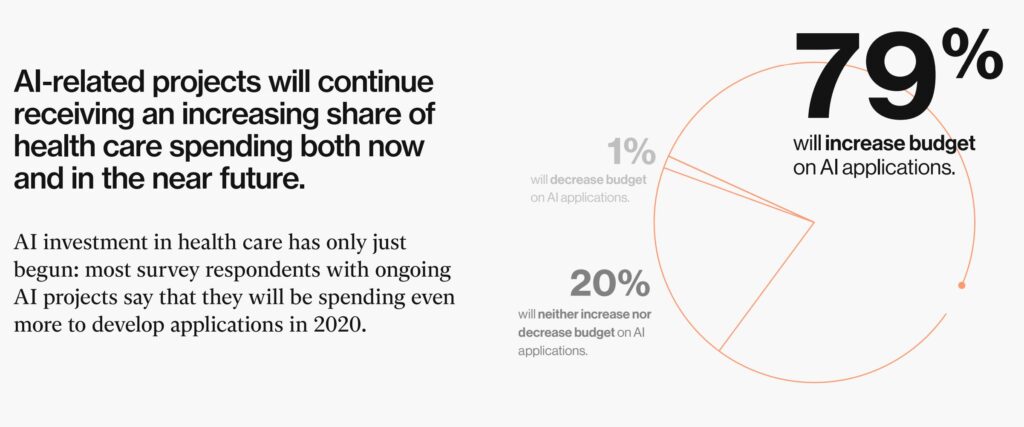
MIT Technology Review and GE Healthcare
Reskilling the Workforce
Given the interdisciplinary nature of AI, the practices delivering and supporting AI solutions need to be methodically structured and staffed with appropriate resources to balance the central and supporting activities’ breadth and depth requirements. Within this context and the rapid velocity of workplace change, there is a real need to expand educational and skills development related to the underlying technologies and use cases. As practical productivity and profitability influencers, the arrival of AI has also increased a sense of urgency for immediate investment in training and knowledge-building programs.
Similarly, we’re already seeing increasing demand for new digital and other technical skills, with critical shortages appearing in other professional disciplines. This resourcing condition expands beyond programming and other related fields growing in value as we enter the world’s Fourth Industrial Revolution. It is not just a question of encouraging employees to acquire new skills, but of finding new approaches and techniques to assist them in developing the skills needed for workplace success.
The critical skills supporting superior AI competencies consist of both hard and soft skills requirements. For example, soft skills identified as positive enablers for workers engaged in AI activities include communication, negotiation, initiative-taking, adaptability, and continuous learning. The hard skills encompass data science, computer science, mathematics, and specific domain expertise. To successfully deliver AI-based solutions, having strong knowledge in the problem’s domain, it is vital to deploy innovative systems that are provably correct, performant, and well optimized.
The AI age will require healthcare organizations to rethink their roles and responsibilities for the talent to ensure success and sustainability in a very dynamic and competitive environment. The three new critical employee roles that support these goals include:
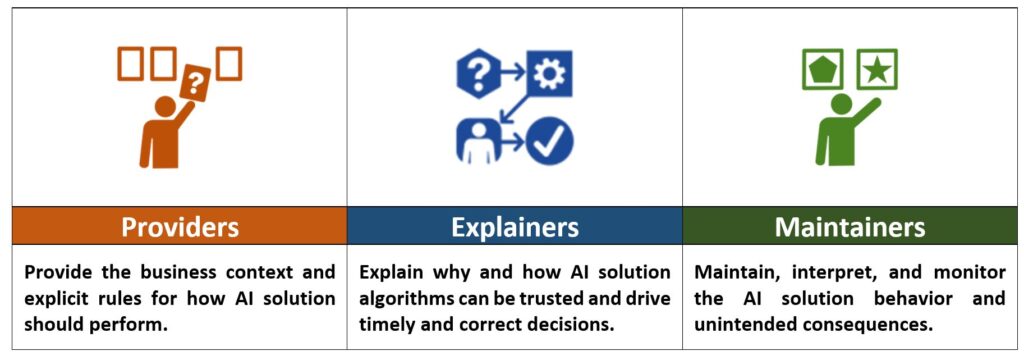
In the future, business leaders must emphasize both reskilling and upskilling. An AI-competent employee population’s primary value will result in improved productivity and profitability generated by a more mobile and more flexible workforce.
“Business leaders are aware of the massive reskilling efforts required to build an AI-ready workforce. However, 22 percent of business leaders felt that workers have no interest in reskilling, but only 8 percent of workers feel the same. In addition, 48 percent of business leaders feel that workers do not have enough time to reskill, but only 34 percent of workers feel the same way.”
IDC / Microsoft
American Medical Association (AMA) & AI
The American Medical Association (AMA) adopted policy, H-480.940, “Augmented Intelligence in Health Care,” to provide a comprehensive framework for the evolution of healthcare artificial intelligence (AI). The policy ensures that AI delivers real benefits for patients, physicians, healthcare facilities, and other stakeholders.
The AMA H-480.940 Policy supports the development of thoughtfully designed, high-quality, clinically validated health care AI solutions. Critical characteristics of AMA recommended AI cover the below.
- Designed and evaluated in keeping with best practices in user-centered design, particularly for physicians and other health care team members;
- Transparent;
- Conforms to leading accepted reproducibility standards;
- It identifies and takes steps to address bias and avoids introducing or exacerbating health care disparities, including testing or deploying new AI tools on vulnerable populations;
- Safeguards patients’ and other individuals’ privacy interests and preserves the security and integrity of personal information.
AI and IT Governance
Information Technology Governance (IT Governance) is a structure used to set-up, monitor, and control critical information technology assets to ensure strategic alignment with its business goals.
IT Governance consists of formal policies, practices, and processes that ensure the effective, efficient, safe, and ethical use of corporate technology. At its core, this mechanism must clearly define how an organization manages and leverages its IT portfolio, including financial, system, and employee resources. The valuable outcome provides mission-critical oversight for the practical evaluation, selection, prioritization, and funding of IT projects, ensuring their successful implementation and continual monitoring and making required adjustments to meet business requirements and goals.
For many companies, the incorporation of AI technologies is a new experience that will require research, assessment, and possibly changes to the current corporate IT environment. AI’s potential value and dangers raise concerns among business leaders on the accuracy, fairness, transparency, trust, ethics, privacy, and security of intelligent solutions. IT Governance provides the structure for the successful management of these problems and risks.
The key questions that need answering with strategic consideration within a corporate AI adoption plan include the items outlined below.
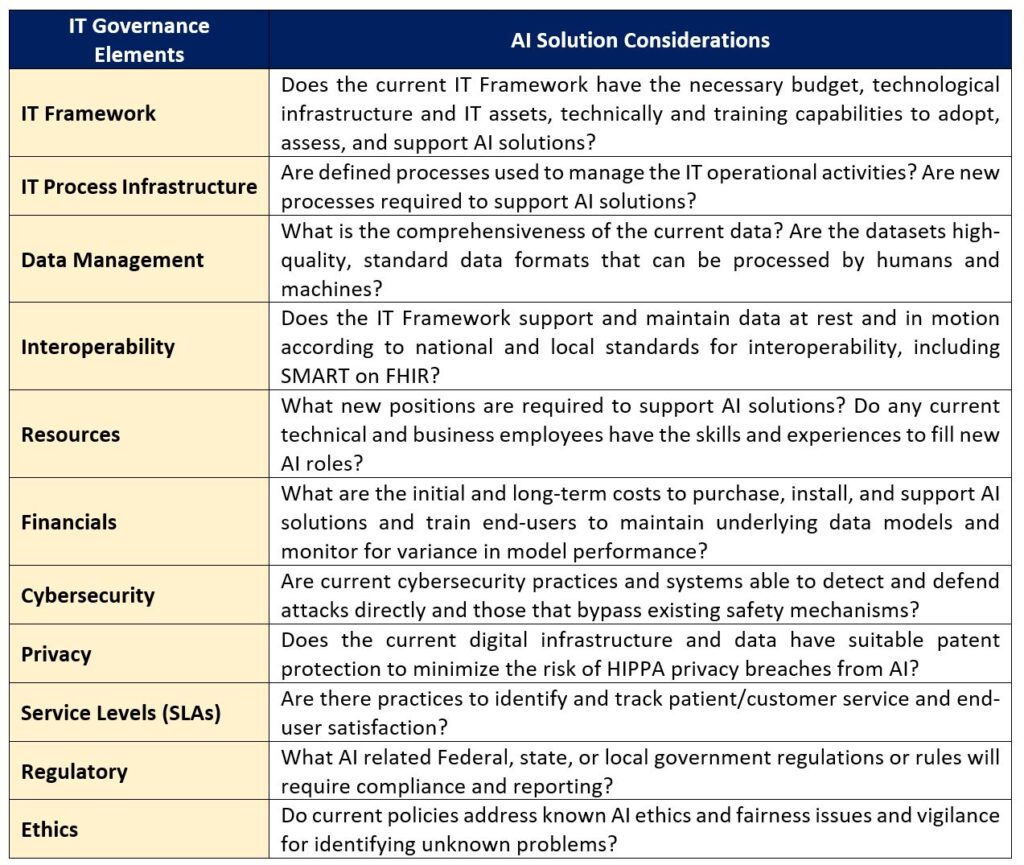
“AI and machine learning is being infused into every experience in a deep way, and you’re going to see a lot of that. The experience itself is no longer bound to one device, it’s becoming multi-sense and multi-device. We’re not stopping at the cloud.”
Satya Nadella
The Way Forward
At Knowledge Compass, we bring together nearly four decades of thought leadership in business and technology strategy, the latest tools and best practices, and a seasoned consultant team with the competencies and talent to help our clients improve productivity and profitability.
Knowledge Compass explores and develops valuable new insights from business, technology, and science by embracing the powerful technology of ideas and brainstorming. Our consultants engage customers in challenging discussion and experimentation to expand business science boundaries and practice and translate creative ideas into practical solutions from within and beyond business.
Working with Knowledge Compass means a collaborative approach to understanding your current business model, strategies, and critical business requirements and goals.
We enable organizations to transform and deliver improved value by ensuring employees adapt and make the most effective use of crisis management and change practices in culture, strategy, infrastructure, processing, and digital transformation. Our consultants have a deep understanding of the social and business factors that support a people-based culture aligned with the appropriate corporate strategy and goals.
Knowledge Compass provides consulting services using time-tested best practice frameworks, analysis tools, and interactions from their professional Consultant Toolbox.



0 Comments